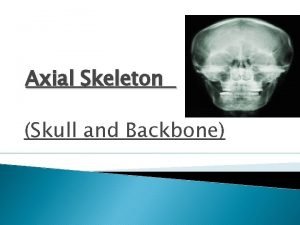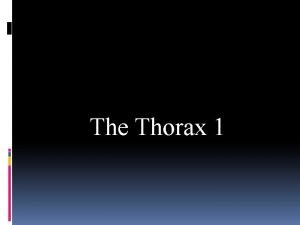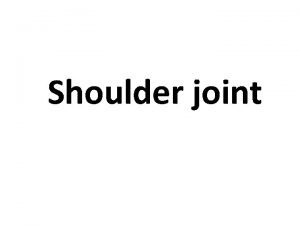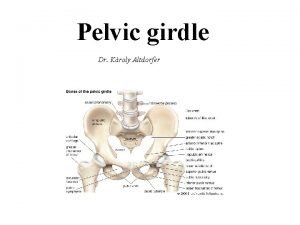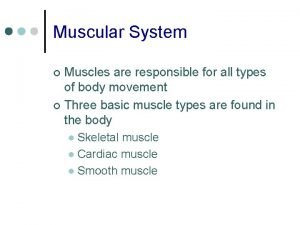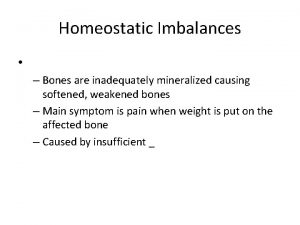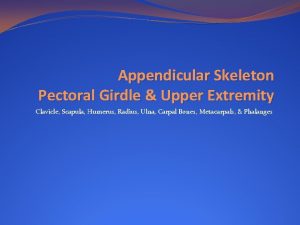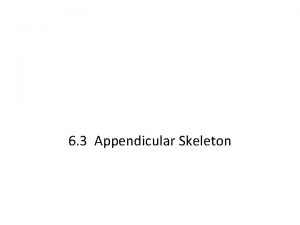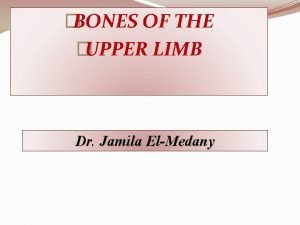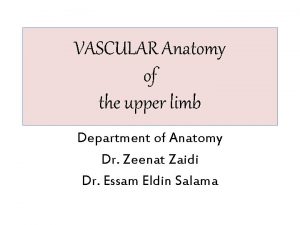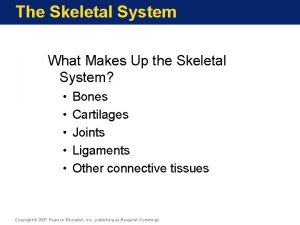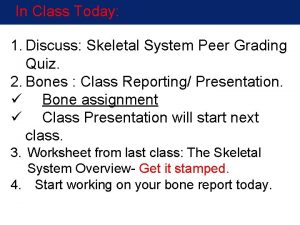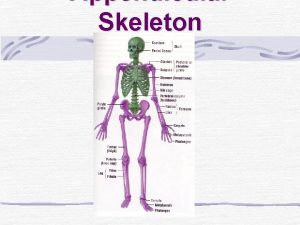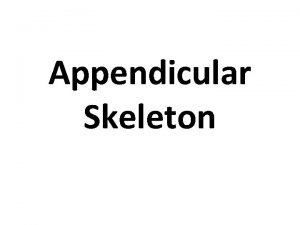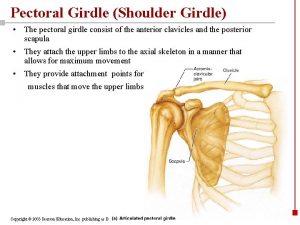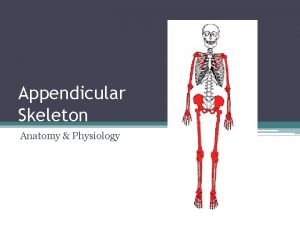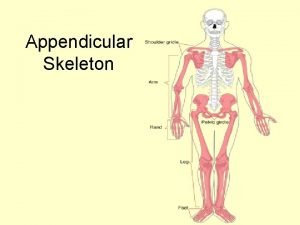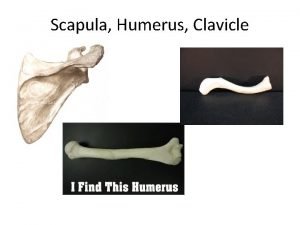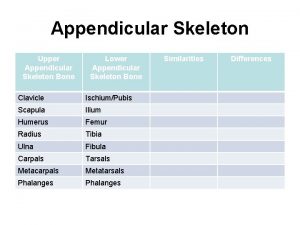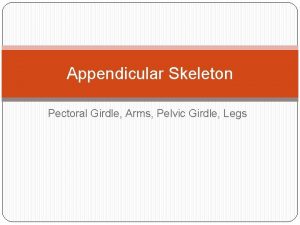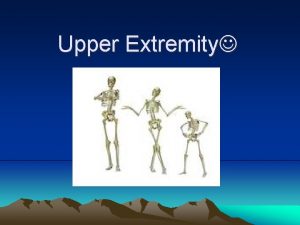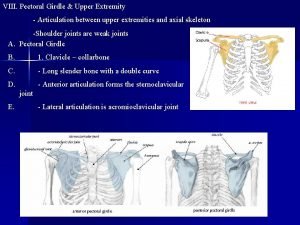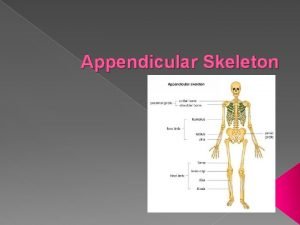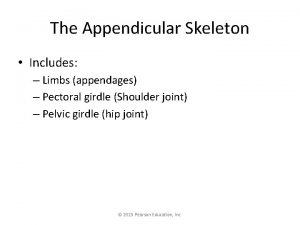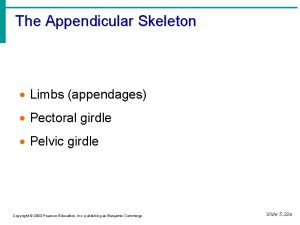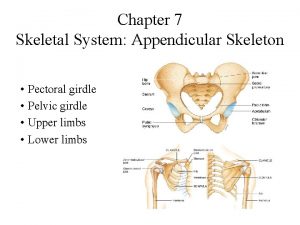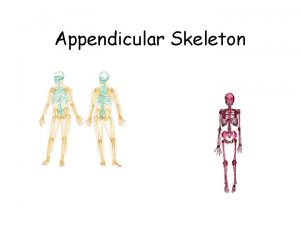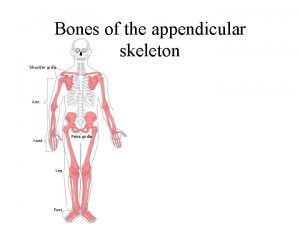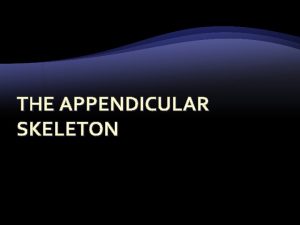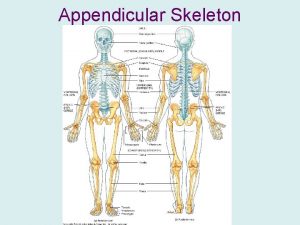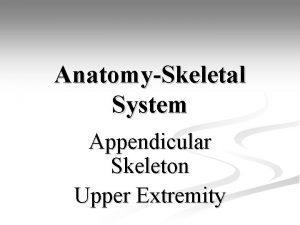Appendicular Skeleton Pectoral Girdle Upper Extremity Clavicle Scapula






















- Slides: 22

Appendicular Skeleton Pectoral Girdle & Upper Extremity Clavicle, Scapula, Humerus, Radius, Ulna, Carpal Bones, Metacarpals, & Phalanges

Pectoral Girdle Clavicle & Scapula (Collar Bone & Shoulder Blade)

Pectoral Girdle � 1 Scapula & 1 Clavicle � The upper extremity it a nonweight bearing joint � The primary function of the pectoral girdle is to provide attachment for the numerous muscles that move the shoulder & elbow

Pectoral Girdle �The pectoral girdle attaches to the axial skeleton anteriorly: Sternoclavicular Joint �The pectoral girdle does not attach to the axial skeleton posteriorly & subsequently, the shoulder has very wide range of motion

Clavicle • The Clavicle is an ‘S’ shaped bone • The clavicle holds the glenohumeral joint (shoulder) away from the body • The clavicle connects the upper extremity to the axial skeleton • The clavicle is the most fractured bone in the body • There is a joint on each end of the clavicle • SC Joint: Sternoclavicular Joint @ Sternal End (medial) • AC Joint: Acromioclavicular Joint @ Acromial End (lateral)

Scapula • The Scapula lies over the posterior thoracic cage at ribs 2 -7 • The Scapula is a large, flat, & triangular in shape • The bony landmarks of the Scapula • Spine: between Supraspinous fossa & • Supraspinous Fossa: Supraspinatus • Infraspinous Fossa: Infraspinatus • Acromion: AC joint • Glenoid Cavity: articulates w/ Humeral Head • Subscapular Fossa: Subscapularis • Coracoid Process: Biceps attachment • Medial Border (Vertebral Border) • Lateral Border • Inferior Angle • Superior Angle Infraspinous fossa

Scapula Figure D Figure E Figure L

Brachium Humerus (Upper Arm)

Brachium • • • The Brachium is aka the Upper Arm The bone in the upper arm is the Humerus. The Humerus is the longest bone in the upper extremity The Humerus articulates with the Glenoid Cavity; this articulation is know as the Glenohumeral joint (shoulder) The bony landmarks of the Humerus are: • • • Proximal Head Anatomical Neck Greater Tubercle Lesser Tubercle Intertubecular Groove Surgical Neck Body Deltoid Tuberosity Lateral Epicondyle Medial Epicondyle Olecranon Fossa

Humerus • • • #1 #2 #4 #5 #6 #7 #10 #12 #13

Review �#1 Manubrium Sternum �#2 Sternoclavicular Joint �#3 Clavicle �#4 Acromioclavicular Joint �#5 Glenohumeral Joint �#6 Scapula �#7 Rib (five) �#8 Humerus

Antebrachium Ulna & Radius (Forearm)

Antebrachium � Forearm � Ulna: medial bone � The Ulna articulates with the Humerus (proximal) & the radius (proximal & distal) � � � Trochlear Notch Olecranon Process Coronoid Process Ulnar Styloid Process Ulnar Head � Radius: lateral bone � The Radius articulates with the Humerus (proximal), the ulna (proximal & distal), & the carpal bones (distal end of radius) � � Radial Head Radial Styloid Process Radial Tuberosity Ulnar Notch

Radius & Ulna Review � Figure 1 � � � A B C D E F G H I J K L � Figure 2 � � � � A C D F J K L

Carpus Carpal Bones (Wrist)

Carpal Bones � 8 Carpal Bones form the wrist �There are 2 rows of carpal bones �Proximal Row �Scaphoid �Lunate �Triquetrum �Pisiform �Distal Row �Hamate �Capitate �Trapezoid �Trapezium

Carpus • • A: • Scaphoid • Lunate • Triquetrum • Pisiform • Hamate • Capitate • Trapezoid • Trapezium B C: D: E: F: G: H:

Metacarpus Metacarpal Bones (Palm)

Metacarpals � There are 5 Metacarpal Bones, numbered 1 -5 starting with the thumb � Each Metacarpal has a : � Base (proximal): carpometacarpal joint � Body (middle) � Head (distal): metacarpophalageal joint, the head of the metacarpal articulates with the proximal phalanx & forms the knuckles

Phalanges Phalanx Bones (Fingers)

Phalanx Bones � There are 14 phalanx bones in each hand � The thumb is the 1 st phalange & only consists of 2 phalanx bones � Proximal Phalanx � Distal Phalanx � Phalanges 2 -5 consist of 3 phalanx bones each � Proximal Phalanx � Middle Phalanx � Distal Phalanx � 3 Joints: � Metacarpophalangeal Joint: ‘MCP Joint’ articulation of metacarpals & phalanges � Proximal Interphalangeal Joint: ‘PIP Joint’ articulation of Proximal phalanx & distal phalanx � Distal Interphalangeal Joint: ‘DIP Joint’ articulation of distal phalanx & middle phalanx

The Pectoral Girdle & Upper Extremity Clavicle Scapula Humerus Radius Ulna Carpal Bones Metacarpal Bones • Phalanx Bones • •
 Anatomy and physiology chapter 8 skeletal system
Anatomy and physiology chapter 8 skeletal system Skeletal system
Skeletal system Axial vs appendicular skeleton
Axial vs appendicular skeleton Axial vs appendicular skeleton
Axial vs appendicular skeleton Appendicular vs axial skeleton
Appendicular vs axial skeleton Muslce
Muslce Synchondrosis
Synchondrosis Pectoral girdle muscles
Pectoral girdle muscles Pectoral girdle
Pectoral girdle Homeostatic imbalances of the skeletal system
Homeostatic imbalances of the skeletal system The pectoral girdle
The pectoral girdle Mlpp glenohumeral
Mlpp glenohumeral Pectoral girdle
Pectoral girdle Wiley
Wiley Biding pektoral girdle and humerus
Biding pektoral girdle and humerus Maggie knott pnf
Maggie knott pnf Upper limb dermatome distribution
Upper limb dermatome distribution What is a closed kinetic chain
What is a closed kinetic chain East bay hand & upper extremity
East bay hand & upper extremity Deep veins upper extremity
Deep veins upper extremity The biomechanics of the human upper extremity
The biomechanics of the human upper extremity Figure 6-4 the skeleton axial and appendicular divisions
Figure 6-4 the skeleton axial and appendicular divisions Figure 6-4 the skeleton axial and appendicular divisions
Figure 6-4 the skeleton axial and appendicular divisions


